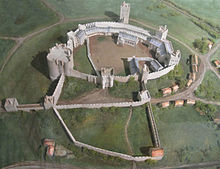Barbican
The barbican (also called the barbican ) is a defensive work in the form of a round bastion in front of the gate of a late medieval or renaissance castle or city wall . The round design in classic Baumanier served as a cannon bastion without a preferred direction for the aiming of the cannons freely positioned there. The barbican originated in an attempt to react to firearms in the second half of the 15th century by adding additional defensive and protective structures to the gates. Later ravelins were used in a similar function.
Demarcation
In contrast to the gate kennel , the barbican was not or only partially connected to the curtain wall and was not infrequently built on the other side of the moat.
Examples in Central Europe
The largest surviving barbican in Europe is the barbican in front of Florian's Gate in Krakow , Poland . There are other barbican in Görlitz (the Kaisertrutz at the Kulturhistorisches Museum Görlitz ), in Naumburg an der Saale at the Marientor , in Jena at the Powder Tower, in Rothenburg ob der Tauber , in Aachen at the Ponttor , in Nuremberg (reconstruction), in Warsaw (reconstruction) , at the Marienburg , in the area of the city castle Banská Bystrica , in Moscow , in York (Walmgate Bar), in the old town of Carcassonne and at Fort de Salses in the French Pyrenees . A - albeit small - barbican stands as a gate protection in front of Friedland Castle in the town of the same name in Bohemia .
Angled route through the barbican of the Lazarus Gate in Avignon
Barbican in front of the Neuhauser Tor in Munich
Iberian Peninsula
In the Spanish-speaking area, there is a special feature of the Torre Albarrana ( Arabic براني, DMG barrānī = "outside"; English: "Albarrana tower"). The specific construction is that the Torres albarranes are mostly rectangular or polygonal.
The towers were built by the Moors when they conquered the Iberian Peninsula between the 8th and 14th centuries . Especially in the 12th century at the time of the Almohads , these fortifications were built in southern Spain.
The towers were erected several meters in front of the defensive wall (curtain wall) and could only be reached via a bridge from the wall. The bridge was often connected to the wall by a removable wooden structure. The oldest Albarranas were pentagonal or octagonal (for example in Badajoz, Tarifa, Seville). In the course of time, a more rectangular floor plan prevailed.
The most famous specimens:
- Torre de Espantaperros in Badajoz . Probably one of the first towers of this type, built by Abu Yaqub Yusuf in 1170 with an octagonal floor plan.
- Torre del Oro , Torre de la Plata in Seville
- Torre de la Malmuerta in Cordoba
- several towers in Talavera de la Reina
- Òdena , castle near Barcelona
- Castelo de Paderne in Portugal
- two towers at the Castillo de Santa Catalina in Jaén
- Loulé Castle in Portugal
Castelo de Paderne (Portugal)
One of the two Torres Albarranes in Santa Catalina Castle in Jaén
Loulé Castle (Portugal)
Possibly the only example of an Albarrana in England is at Pontefract Castle . The castle is now in ruins, but the Albarrana Swillington Tower can be clearly seen in the remains of the castle on the north side.
See also
literature
- Peter Burton: Islamic Castles in Iberia. In: The Castle Studies Group (Ed.): The Castle Studies Group Journal. Volume 21. 2007-2008, ISSN 1741-8828 , pp. 228-244 ( PDF ; 1.6 MB).
- Michael Losse : Barbican. In: Horst Wolfgang Böhme , Reinhard Friedrich, Barbara Schock-Werner (Hrsg.): Dictionary of castles, palaces and fortresses. Philipp Reclam, Stuttgart 2004, ISBN 3-15-010547-1 , pp. 73-74, doi: 10.11588 / arthistoricum.535 .
Web links
- elperiodicoextremadura.com ( page no longer available )
- castlesofspain.co.uk ( Memento June 6, 2014 in the Internet Archive )











